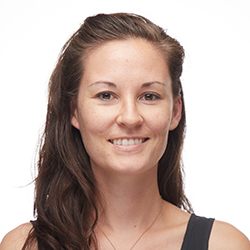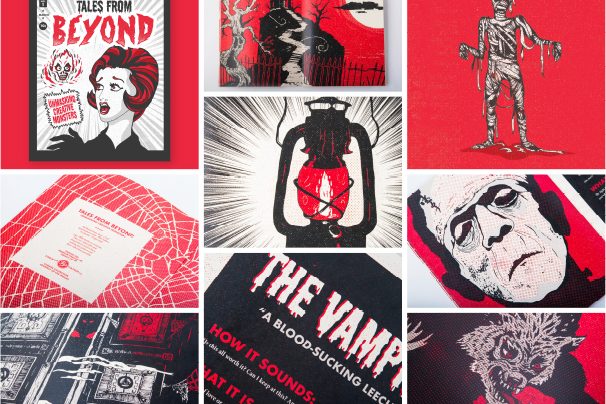
Graphic Design &
Visual Experience
Graphic Design
See Differently
CBU Graphic Design & Visual Experience program is built with the industry in mind. As a true design program, and premier Christian design school, the program is authored by professional designers with a tested understanding for what makes young designers successful. Best practices, latest technologies, ideation, craft, and business acumen are embedded into the instruction and mentorship – all with the intention of sending the designer out to make an impact for the Kingdom where image, brand and message are paramount.
CBU Graphic Design & Visual Experience offers a flexible undergraduate degree which allows for the student to receive a solid design foundation, and built on it with their choice of digital media specialization.
Graphic Design & Visual Experience Concentrations
CBU Design offers five concentrations, allowing students to specialize and distinguish themselves as designers who demonstrate professional excellence and personal integrity, are servant leaders in their communities and who live biblically-based, missional lives within the profession.
National Rankings – CBU Graphic Design
Intellegent.com
2021: Ranked “Best for Visual Experience Design”
2021: Ranked “Best Christian Institution”
Previous National Rankings
#1 – Affordablecolleges.com
#1 – Oedb.org
#2 – Collegechoice.net
#2 – Thebestschools.org
#5 – Bestchoiceschools.com
#6 – Bestvalueschools.com
#8 – Guidetoonlineschools.com
#15 – Successfulstudent.org
News
Ready to See Differently?
Discover. Define. Ideate. Prototype. Test.
Our demand of the student is simple. See Differently.
B.A. Graphic Design & Visual Experience
The Graphic Design and Visual Experience major prepares students for careers in professions including graphic design, photography, web design, emerging media design and video/animation. The students will learn the technologies, trends and principles employed by professionals in these fields. The program is based around hands-on projects and portfolio building.
General Education Courses
The general education requirements will follow the curriculum set forth for other university programs. Some general education requirements will be met through specific major requirements.
Lower Division Requirements
ART 201 Principles of Design and Color
Units: 3. Offered: Fall, Spring.
An introduction to the principles of two-dimensional design and color theory and their use as tools for effective visual communication.
ART 204 Drawing I
Units: 3. Offered: Fall, Spring.
This course is one of the foundation courses that develop the perceptual and technical skills for effective drawing. Presents drawing as an essential tool for visual expression. May be repeated once for credit. This course is also recommended for general education.
DES 101 Design Technology Applications I
Units: 3. Offered: Fall, Spring.
This is an introduction to the essential computer software tools used in the modern production of information society, with a focus on the workflow and productions native to design oriented tasks utilized in design and allied design professions. Students will be introduced to foundational design software applications – including Adobe Photoshop, Illustrator, and InDesign – and will be introduced to other workflow applications such as word processing, presentations, spreadsheets, databases, and email. Project based learning activities will provide hands-on experiences for student to practice and apply skills to real-world situations.
DES 110 Creativity: Process and Purpose
Units: 3. Offered: Fall, Spring.
This course provides an introduction to creativity through discussion and project-based learning. The course provides overview and practice of creative processes (e.g. ideation, research, empathy, proto-typing, etc), in-depth discussion of the theological foundations for creativity, and practice for developing creative habits.
GDM 215 Principles: Introduction to Graphic Design
Units: 3. Offered: Fall, Spring.
This foundational course provides a broad introduction to the field of visual communication by exploring 2D design concepts, processes, techniques, and production methods. Students will gain experience in the ideation, research, execution, and presentation of design related projects.
GDM 225 Principles: Letterforms and Structure
Units: 3. Offered: Fall, Spring.
Students will learn the fundamentals of typesetting and typographic layout by exploring the history, anatomy, vocabulary, design, and function of letterforms and the role it plays in the visualization of language.
GDM 235 Principles: Image Visualization
Units: 3. Offered: Fall, Spring.
This course explores the use of the image as a tool for non-verbal communication and story-telling. Students will learn the fundamentals of image based design through compositing and editing techniques and processes.
GDM 240 Principles: Innovations in Design
Units: 3. Offered: Fall, Spring.
This course surveys the conceptual underpinnings of the major movements in graphic design and digital art. Students will examine visual communication from the earliest human expressions of cave paintings to contemporary design movements to the software breakthroughs of the Digital Revolution. Students will interpret selected concepts and movements and then create their own designs using a variety of analytic methodologies.
PHO 105 Digital Photography
Units: 3. Offered: Fall, Spring.
Students will understand, and become comfortable, with the foundational use of the camera by understanding exposure through metering and the relationship between – ISO, Aperture, and Shutter Speed. Students will begin to implement foundational design elements through composition, and compression through different lens focal lengths. Students will produce and analyze photographs by employing professional photographic techniques and the introduction of a digital workflow.
Upper Division Requirements
DES 310 Creativity: Collaboration and Context
Units: 3. Offered: Fall.
This course builds on a foundational understanding of creativity’s process and purpose. The aim of the course is for students to apply these foundations to the act of completing interdisciplinary creative projects in context. Prerequisite: DES 110.
DES 498 Portfolio
Units: 3. Offered: Fall, Spring.
This is an interdisciplinary course where students will focus on their portfolios and final presentation specific to their industry. Standards in presentation and expectations will be examined to set guidelines for the student’s efforts in portfolio building. The goal of this course is for the student to finish with a strong, cohesive and compelling portfolio of student work. This course should focus on presentation beyond the capstone projects required for graduation.
GDM 315 Practice: Designing Brand Identity
Units: 3. Offered: Fall, Spring.
This course will explore how to develop, conceptualize and craft effective design solutions in the form of a visual identity system. Students will design a variety of branding elements and strategy guidelines to visually communicate a core message across an array of products, services, and environments. Prerequisite: GDM 215
GDM 325 Practice: Typographic Form and Space
Units: 3. Offered: Fall, Spring.
The goal of this course is to refine the student’s skills and understanding in using typography as an informative medium. Students will analyze the semiotic function of text including its relationship with content and image. Students will work with visible language in a variety of media and dimension, exploring the possibilities of conceptually-based typographic solutions. Prerequisite: GDM 225
GDM 335 Practice: Conceptual Image Making
Units: 3. Offered: Fall, Spring.
This course will explore how to critically interpret and create meaning in context. Students will design solutions to problems across a variety of media by visualizing conceptual ideas through advanced image-making processes. Prerequisite: GDM 235
GDM 342 Motion Design I, OR GDM 351 3D Concept Design I
Units: 3. Offered: Fall.
GDM 342 Motion Design I
This course teaches students the fundamental skills and processes used in the motion design industry. Students will learn about storyboards, style frames, sound development, and rendering and they will use industry-standard time-based software such as Adobe After Effects to learn 2D animation principles. Prerequisites: GDM 315 or 325. Offered Fall Odd Years.
GDM 351 3d Concept Design I
This course builds a foundation for advanced 3D environmental modeling, photorealistic rendering, stylistic shading, and effects processes. Students will build upon fundamental techniques to create professional quality imagery and motion with industry standard software such as Cinema 4D and Element 3D. Working is a typical design studio pipeline, students will work with NURBS modeling and mesh editing for hard surface and organic objects; texture mapping, special effects including effectors, dynamics, and multiple emitters; optimization techniques; and a variety of compositing methods to create both artistic works and commercial products. Prerequisites: EGR 121, FLP 170, GDM 215. Offered Fall
GDM 371 UI/UX Design I
Units: 3. Offered: Spring.
This course takes a deep dive into designing UI / UX for mobile and emerging technologies and will critically examine conceptual innovations in the field. On a practical level, students will work with information architecture, prototyping and wireframing tools, usability assessment, and best practices for design communication. Finally, students will work with the major principles and professional practice of UI/UX design through weekly exercises, class discussions, presentations, and functional projects. Prerequisite: 215, 225, 235
GDM 495 Design Capstone
Units: 3. Offered: Spring.
This course prepares students for their capstone show by bringing together the skills and processes students have developed here at California Baptist University. Students begin by identifying an area of research and discussing its relationship to graphic design and visual experience while being challenged to expand their abilities of creating visual form with integrity and meaning. This course is viewed by the program as the pinnacle event in their academic journey. Prerequisite: Senior Status and Permission of the Dean.
PHI 312 Beauty
Units: 3. Offered: Spring.
An introduction to philosophical aesthetics, which has been marginalized and often ignored in philosophical discourse during the past four hundred years. During the last few decades the questions posted by aesthetics have moved back into the center of the philosophical discussion, including the use of the concept by “post-modern” thinkers. The course seeks to bring the student into the longer conversation concerning beauty, “retrieve” important elements that have been lost, and provide a basis for further study. Prerequisite: ARC 210, ART 242, DES 310, FLM 250, GDM 310, ILL 210, PHI 213, or PHO 330.
Concentration Courses
Students must complete all requirements (15 units) in one of the following concentrations: Graphic Design; Illustration; Motion Design; Photography; Visual Experience Design.
See concentrations tab for details.
Student Learning Outcomes
Graphic Design & Visual Experience Student Learning Outcomes (SLO)
- Examine the principles of professional typography.
- Apply the principles of professional design techniques and best-practices workflows.
- Use the principles of professional photography, imaging techniques, and best-practices workflows.
- Use the principles of professional web design techniques and best-practices workflows.
- Effectively present the initial concepts and final design implementation orally and in writing.
- Apply techniques to solve design problems from creation, through production, to final implementation.
- Work proficiently with the industry standard software.
- Integrate business concepts related to graphic design industry.
- Apply a Christian worldview to the moral and ethical questions inherent in the graphic design industry.
- Articulate the Christian graphic designer’s place in the Kingdom of God.
- Apply techniques of professional presentation and promotion in the graphic design industry.
- Apply techniques of professional graphic design to build a professional portfolio of work.
Graphic Design & Visual Experience Minor
24 Units
The Graphic Design and Visual Experience minor allows students majoring in another degree path to become introduced and practiced in the fundamental skills and processes within graphic design. Students are required to complete 24 units as listed below.
Lower Division Requirements
DES 101 Design Technology Applications I
Units: 3. Offered: Fall, Spring.
This is an introduction to the essential computer software tools used in the modern production of information society, with a focus on the workflow and productions native to design oriented tasks utilized in design and allied design professions. Students will be introduced to foundational design software applications – including Adobe Photoshop, Illustrator, and InDesign – and will be introduced to other workflow applications such as word processing, presentations, spreadsheets, databases, and email. Project based learning activities will provide hands-on experiences for student to practice and apply skills to real-world situations.
GDM 215 Principles: Introduction to Graphic Design
Units: 3. Offered: Fall, Spring.
This foundational course provides a broad introduction to the field of visual communication by exploring 2D design concepts, processes, techniques, and production methods. Students will gain experience in the ideation, research, execution, and presentation of design related projects.
GDM 225 Principles: Letterforms and Structure
Units: 3. Offered: Fall, Spring.
Students will learn the fundamentals of typesetting and typographic layout by exploring the history, anatomy, vocabulary, design, and function of letterforms and the role it plays in the visualization of language.
GDM 235 Principles: Image Visualization
Units: 3. Offered: Fall, Spring.
This course explores the use of the image as a tool for non-verbal communication and story-telling. Students will learn the fundamentals of image based design through compositing and editing techniques and processes.
Upper Division Requirements
GDM 315 Practice: Designing Brand Identity
Units: 3. Offered: Fall, Spring.
This course will explore how to develop, conceptualize and craft effective design solutions in the form of a visual identity system. Students will design a variety of branding elements and strategy guidelines to visually communicate a core message across an array of products, services, and environments. Prerequisite: GDM 215
GDM 325 Practice: Typographic Form and Space
Units: 3. Offered: Fall, Spring.
The goal of this course is to refine the student’s skills and understanding in using typography as an informative medium. Students will analyze the semiotic function of text including its relationship with content and image. Students will work with visible language in a variety of media and dimension, exploring the possibilities of conceptually-based typographic solutions. Prerequisite: GDM 225
GDM 335 Practice: Conceptual Image Making
Units: 3. Offered: Fall, Spring.
This course will explore how to critically interpret and create meaning in context. Students will design solutions to problems across a variety of media by visualizing conceptual ideas through advanced image-making processes. Prerequisite: GDM 235
Choose 3 units from the following:
GDM 415, GDM 425, GDM 435
Graphic Design & Visual Experience Concentrations
CBU Graphic Design & Visual Experience offers five paths of specialization within Graphic Design & Digital Media degree. These concentrations allow students to specialize and distinguish themselves as designers who demonstrate professional excellence and personal integrity, are servant leaders in their communities and who live biblically-based, missional lives within the profession.
Concentrations require twelve (15) additional units of upper level coursework from a specific set of courses as listed below.
Graphic Design
The Graphic Design concentration allows for students to take their fundamental graphic design skill to new levels and new applications. Students in this concentration emerge with a well developed, competitive, and diverse portfolio – setting themselves up for advanced employment opportunities.
Complete twelve (15) units from the following:
GDM 415 Studio: Visual Systems Design (6 Units)
Units: 3. Offered: Fall, Spring.
This studio-based course is expected to be the culmination and synthesis of visualizing complex, integrated design systems from the skills acquired in prior courses within the major. Through key principles in visual systems design, each student will contextualize and develop strategies for managing design solutions across a variety of communication outlets. Repeatable for a maximum of six (6) units. Prerequisite: GDM 315, 325, 335
GDM 425 Studio: Typographic Hierarchies
Units: 3. Offered: Fall.
This experiential studio course is expected to be the culmination and synthesis of the typographical knowledge and skills acquired from the successful completion of prior courses within the major. By exploring and discussing historical and contemporary theory related to typography and design, each student will contextualize and apply critical thinking to their developing practice and conceptual interests. Repeatable for a maximum of six (6) units. Prerequisites: GDM 315, 325, 335
GDM 435 Studio: Image and Art Direction
Units: 3. Offered: Fall.
This experiential studio course is expected to be the culmination and synthesis of the creative image-making knowledge and skills acquired from the successful completion of prior courses within the major. Studio emphasis is placed on strategic and conceptual art direction for products and subjects. Repeatable for a maximum of six (6) units. Prerequisites: GDM 315, 325, 335
Choose 3 Units from the following:
GDM 342, GDM 351, GDM 371, GDM 425, GDM 435, ILL 350, PHO 332
Illustration
The Illustration concentration develops students in the art of visual and conceptual storytelling enabling them to be strategic and effective communicators in our visual culture. Students can gain skills that can be applied to animation, book illustration, game design, graphic novels, medical illustrator, forensic artist, story-board artist, or art director.
Complete sixteen (15) units from the following:
GDM 425 Studio: Typographic Hierarchies
Units: 3. Offered: Fall.
This experiential studio course is expected to be the culmination and synthesis of the typographical knowledge and skills acquired from the successful completion of prior courses within the major. By exploring and discussing historical and contemporary theory related to typography and design, each student will contextualize and apply critical thinking to their developing practice and conceptual interests. Repeatable for a maximum of six (6) units. Prerequisites: GDM 315, 325, 335
ILL 210 Illustration I
Units: 3. Offered: Spring.
This course builds a working knowledge of the historical and contemporary illustrators and various styles and approaches to the craft. Projects will build important skills in drawing painting, color theory, storytelling and typography.
ILL 310 Illustration II
Units: 3. Offered: Fall.
This course will build a working knowledge of ideation, story building, technique and experimentation with media. Projects will build important art execution skills, as well as technical knowledge in the publishing industry. Pre-Requisite: ILL 210.
ILL 350 Digital Painting II
Units: 3. Offered: Spring.
This course is an advanced digital painting methods course that moves beyond basic digital workflows and software into advanced digital illustration techniques for composition, color, contrast, and value as a means to effective storytelling. Pr-requisite: ILL 250 or GDM 235
Choose 3 units from the following:
GDM 415, GDM 425, GDM 435
Motion Design
Technology is expanding the domain of the design student into areas of motion gfx, animation, and other story telling mediums. This concentration affords and encourages this development, believing that it is paramount the students have some exposure and development in the motion arts.
Complete twelve (15) units from the following:
GDM 342 Motion Design I
Units: 3. Offered: Fall.
This course teaches students the fundamental skills and processes used in the motion design industry. Students will learn about storyboards, style frames, sound development, and rendering and they will use industry-standard time-based software such as Adobe After Effects to learn 2D animation principles. Prerequisite: GDM 315 or GDM 325
GDM 343 Motion Design II
Units: 3. Offered: Spring.
This upper-level course teaches advanced motion theory, as well as pipeline workflow concepts, strategies and common industry trends and practices. The emphasis is on showing the full motion design workflow in a studio-like environment from concept to final output. Prerequisite: GDM 342
GDM 351 3D Concept Design I
Units: 3. Offered: Fall.
This course builds a foundation for advanced 3D environmental modeling, photorealistic rendering, stylistic shading, and effects processes. Students will build upon fundamental techniques to create professional quality imagery and motion with industry standard software such as Cinema 4D and Element 3D. Working is a typical design studio pipeline, students will work with NURBS modeling and mesh editing for hard surface and organic objects; texture mapping, special effects including effectors, dynamics, and multiple emitters; optimization techniques; and a variety of compositing methods to create both artistic works and commercial products. Pre-requisite: GDM 215 OR EGR 121
GDM 352 Visual Effects Concept Design
Units: 3. Offered: Fall.
This course teaches students the primary skills and processes used in the visual effects (VFX) industry. Students will learn basic compositing and how to integrate computer graphics and 3D components with live action in a methodology that simulates standard VFX production pipelines. Pre-requisite: GDM 215 or FLP 170 or EGR 121
GDM 455 Studio: Visual Experience Design
Units: 3. Offered: Fall.
This experiential learning course teaches students to develop a disciplined studio digital arts and design practice. Advanced Design Studio explores leading-edge ideas and design methodologies and directs each student to develop specific concepts, processes, and techniques in relation to their developing practice and conceptual interests. Students will develop an individualized area of research, and a directed, productive approach to studio practice. Finally this course will introduce and discuss professional practices in digital arts and design in order to prepare students for careers in design, the arts, exhibitions, graduate study, professional practices, self-promotion, or various other creative pursuits. Repeatable for a maximum of six (6) units. Prerequisites: GDM 315, 325, 335, and either GDM 343 or 353
Photography
The Photography concentration leverages the resources of CBU’s renown photography department to develop the commercial photography skill sets of graphic design students. The concentration is built with the working designer and photographer in mind, teaching students how to integrate work flows between graphic design processes and photography processes.
Complete fifteen (15) units from the following:
GDM 435 Studio: Image and Art Direction
Units: 3. Offered: Fall.
This experiential studio course is expected to be the culmination and synthesis of the creative image-making knowledge and skills acquired from the successful completion of prior courses within the major. Studio emphasis is placed on strategic and conceptual art direction for products and subjects. Repeatable for a maximum of six (6) units. Prerequisites: GDM 315, 325, 335
PHO 332 Studio Lighting
Units: 3. Offered: Spring.
This course will implement a practical workflow within a controlled space, utilizing the tools and techniques of studio photographers. Students will gain an understanding of light quality and how it relates to ideas, and the emotional depiction of a subject. Students will understand how to craft their lighting to the specific subject they are photographing. Labs will be hands-on, integrating professional studio practices for digital capture and utilizing industry-wide workflow standards related to the latest software and hardware. Pre-Requisite: PHO 105
PHO 350 Digital Printing and Color Management
Units: 3. Offered: Fall.
This course presents students with the digital workflow techniques needed to produce archival photographs. File preparation, resolution selection, print-profiling, paper selection and soft-proofing techniques will be covered. Students will learn the techniques of digital color management by applying color profiles to produce archival prints for the purpose of promotional, gallery, and printed portfolios. Pre-Requisite: PHO 250 or GDM 235
PHO 432 Location Lighting
Units: 3. Offered: Fall.
Students will be able to approach locations efficiently to determine what artificial lighting methods to introduce, to create technically refined photographs. While also introducing these techniques creatively to further demonstrate mastery of photography through the use of location lighting. Prerequisite: PHO 332.
Choose 3 unites from the following:
GDM 415, GDM 425
Visual Experience Design
With the ubiquity of mobile devices, and the coming mainstream adoption of wearables headsets, there will soon exist access for nearly everyone to view and interact with a digital layer of AI structured data overlayed onto the physical spaces and in completely immersive digital environments. It is in light of this coming need that this hands-on, project-driven curriculum centers on teaching students to build more traditional (3D, VFX) and emerging media (AR, VR, AI) deployments centered in well-researched intellectual concepts intended thoughtfully consider commercial value, artistic merit, and philosophical integrity.
Complete twelve (15) units from the following:
GDM 351 3D Concept Design I
Units: 3. Offered: Fall.
This course builds a foundation for advanced 3D environmental modeling, photorealistic rendering, stylistic shading, and effects processes. Students will build upon fundamental techniques to create professional quality imagery and motion with industry standard software such as Cinema 4D and Element 3D. Working is a typical design studio pipeline, students will work with NURBS modeling and mesh editing for hard surface and organic objects; texture mapping, special effects including effectors, dynamics, and multiple emitters; optimization techniques; and a variety of compositing methods to create both artistic works and commercial products. Pre-requisite: GDM 215 OR EGR 121
GDM 352 Visual Effects Concept Design
Units: 3. Offered: Fall.
This course teaches students the primary skills and processes used in the visual effects (VFX) industry. Students will learn basic compositing and how to integrate computer graphics and 3D components with live action in a methodology that simulates standard VFX production pipelines. Pre-requisite: GDM 215 or FLP 170 or EGR 121
GDM 353 3D Concept Design II
Units: . Offered: Spring (Odd Years).
This course focuses on advanced 3D concept design, compositing, product design, environmental modeling, photorealistic rendering, stylistic shading, and effects processes. Students will learn advanced techniques for 3D compositing into live action videography that includes a variety of methodologies to create both artistic works and commercial products with industry standard software such as Cinema 4D, After Effects, and Premiere. Prerequisite: GDM 351
GDM 354 Mixed Reality Concept Design
Units: 3. Offered: Spring.
With the ubiquity of mobile devices and the mainstream adoption of wearables, there is an additive digital layer of structured data viewable in mixed reality environments such as augmented reality (AR) and virtual reality (VR). This course provides students with an overview of the history and evolution of these technologies, their convergence, and how to build basic mixed reality applications for such domains as the arts, design visualization, architecture, fashion, and other artistic and commercial use cases. Students will use industry standard programs such as Unity 3D and Snapchat Lens. Prerequisite: GDM 351
GDM 455 Studio: Visual Experience Design
Units: 3. Offered: Fall.
This experiential learning course teaches students to develop a disciplined studio digital arts and design practice. Advanced Design Studio explores leading-edge ideas and design methodologies and directs each student to develop specific concepts, processes, and techniques in relation to their developing practice and conceptual interests. Students will develop an individualized area of research, and a directed, productive approach to studio practice. Finally this course will introduce and discuss professional practices in digital arts and design in order to prepare students for careers in design, the arts, exhibitions, graduate study, professional practices, self-promotion, or various other creative pursuits. Repeatable for a maximum of six (6) units. Prerequisites: GDM 315, 325, 335, and either GDM 343 or 353
Launch your Creative Career
Design is taking a lead role in business and broader culture. Companies where design sits at the core of their philosophies, such as Apple, Tesla, AirBnB are succeeding in unprecedented manners. Designers are in high demand to craft the user experience. Graduates from the CBU Graphic Design & Visual Experience program are uniquely equipped and sought after candidates to enter the new economy, as well as uniquely trained to start their own design firms.
Working Designers
88% of graduating students who went to work in the creative fields. Out of the 112 graduates from 2009 to 2014, 77 are working in the creative fields, 20 are unknown, 10 are outside the creative field, 2 are military and 1 is creating seminars.
Award Winning
Over 40 American Advertising Awards have been awarded to CBU design students including:
- “Gold – Elements of Advertising—Still Photography, Campaign”, National Competition
- “Gold – Out-of-Home—Poster”, National Competition
- “Gold” State Competition
- “Best of Show” State Competition
Industry Known
Greg Laurie
Pastor, Harvest Church
harvest.org
“Design Matters. I have had a passion for art and design as long as I can remember. It is second only to my passion for preaching the gospel and teaching the Bible. I am excited about the design program at CBU and hope a new generation of artists will rise up to impact our culture with cutting edge design coupled with the timeless message of Jesus Christ.”
Aaron Lemen
Creative Director
“When we needed to fill our graphic designer position, we didn’t want to cast a wide net. We knew what kind of talent we were looking for. So we reached out to a short list of the best local talent, including the CBU design program. The top portfolios consistently came from CBU and we felt fortunate to bring one onto our team.”
David Riley
David Riley Associates
rileydra.com
“I’ve been fortunate enough to have a long standing relationship with CBU. I’m excited to see that CBU has developed such an outstanding design department that will expand and enrich the lives of these creative individuals.”
Student Work
Faculty
Real World Engagement
Classrooms are integral but they are a place to stagnate. Whether it is a mountain shoot, internship, studio tour, desert shoot, pool shoot, field trip, speaking engagement or just fellowship, we build a community of designers that connect on campus and off. Our students learn to understand the power of their work and grow to direct others — then to change others.
Desert Shoot
The classroom is only the start. Each year, CBU design students arm themselves with cameras and head out to the desert.
Underwater Shoot
Pool. Professional Models. Underwater cameras. Hands-on.
Doing what you do out of school. Doing what the profession does.
On-Location
From the beach to the mountains. Hand-held cameras and drones. CBU students in design learn to apply what they learn in real-life scenarios.
International Service Projects
CBU is committed to fulfilling Jesus’ mandate in the Great Commission “to go and make disciples of all nations.” To this end, CBU believes that God bestows upon every student gifts and passions to accomplish their purpose. To that end, CBU sends out more students worldwide than any other college in the country. For more information see the Office of Mobilization.
Design for Good
Design for Good is an ethos to use problem-solving and design thinking towards social change. CBU joins forces with the AIGA, the professional association for design, to utilize design skills to serve our local community and work towards bringing about social change. For more information on Design for Good program, see the AIGA website.






















































